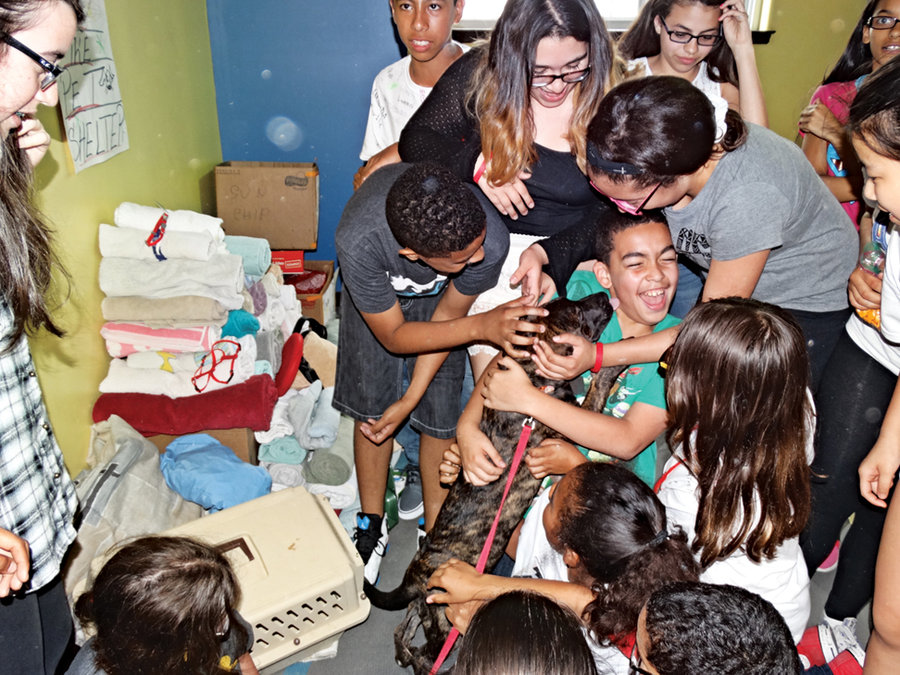Not long ago, Weehawken Animal Control Officer Vincent Ascolese brought a dog to an elementary school in that town for a little love. The dogs who end up in local shelters have a variety of stories to them.
In addition to handling animal control in Bergen County, Ascolese’s organization Bergen County Protection and Rescue runs two no-kill animal shelters, one in Cliffside Park and one in Bloomfield. Through an affiliation with the Hudson County animal control officer, they provide the animal sheltering services for Weehawken, West New York, and Guttenberg.
But that’s not all they do. “Talking to people and educating them is 60 to 70 percent of our job,” he said. “A large part of our organization is education and outreach and the more we do things like this and talk about pet responsibilities, the better it is for the community and the animals.”
He shared some of the stories of the local animals that have wound up under his care.
Promoting no-kill shelters
A former school teacher in Jersey City, Ascolese left his job in 2007 when his wife got ill. After a brief stint as an insurance investigator, he decided to follow his love of animals into a new career.
His brother-in-law, Geoffrey Santini, the animal control officer for Hudson County, sponsored him at the police academy in 2009 and Ascolese launched the Bergen County Protection and Rescue Foundation in 2010.
“We’re considered law enforcement, not police,” he said. “We work directly with the different police departments and the health departments. We do have arrest powers but we don’t go down that route. We don’t carry weapons although we’re allowed to.”
Initially he brought any rescued animals to the nearest no-kill shelter, in South Orange. “We did so much work in South Orange and helped them grow their facility that they encouraged us to open our own,” he recalled. Thus the Cliffside Park shelter opened in 2010 and a second one followed.
And now, “We’re looking to expand to a new building,” he said, because a growing number of towns are opting to work with no-kill shelters. But the foundation needs more funds and more volunteers to make it happen.
“We patrol the streets daily for strays and animals in distress.” –Vincent Ascolese
____________
“If you go into a food pantry you need food for yourself but what about your pets?” he asked. “We try to get food out to the food pantries before they find the necessity for it. Also beds, bowls, collars, leashes. We do that on a weekly basis.”
Dog in the trash
“We were the emergency animal shelter for the Edgewater fire, the Avalon fire,” explained Ascolese. “That was very difficult. One of our adopted dogs was in the fire and got out [of the fire]. We lost a lot of animals in that fire. About 25 cats and dogs were unaccounted for in the end. It was tough. But a good amount got out. We helped people with food, and the public really stepped up and helped with a lot of donations.”
One of the organization’s most memorable rescues was Trooper, a Pit Bull/Wiemaraner puppy. “Trooper was a dog that was dumped in North Bergen and we believe he was kept in cage probably the size of a large cat cage,” said Ascolese.
A DPW worker was collecting trash at curbside when he picked up a box and felt the weight shift inside. “He opened it up and it was a dog,” said Ascolese. “Inside the box was a note that said, ‘Please help me. I can’t walk.’ Not outside the box.”
“His muscles were very badly deteriorated,” said Ascolese. “He was young. Three months, four months. Initially they were going to euthanize the dog because the vet said it won’t be able to survive, and I said no way. When I took this dog out of the crate he crawled to me. I said, ‘We’re going to save this dog’s life.’ ”
And so they did, bringing Trooper to a hydrotherapy facility in South Jersey. The therapist there worked with the dog in a hydrotherapy tank to get its strength back.
“The woman that rehabilitated him, she kept him,” said Ascolese. “She couldn’t let him go. Of the thousands of dogs she helped rehabilitate through her facility, she said, ‘I have to keep this one.’”
The Cliffside Park animal shelter is located at 302 Second St. Visitors are welcome. For more information on the protection and rescue foundation, log on to bcrescues.org. “There are many things on there that people can get involved with: volunteers, transport, donations,” said Ascolese. “Even if they just like us on Facebook, that helps us tremendously because then they see all the things that we’re doing, the rescues, the animals that are available, the opportunities for volunteerism, and it promotes good community involvement.”
Art Schwartz may be reached at arts@hudsonreporter.com.
